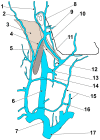Launay's External Carotid Vein
- PMID: 34577908
- PMCID: PMC8472331
- DOI: 10.3390/medicina57090985
Launay's External Carotid Vein
Abstract
Background and Objectives: Launay's external carotid vein (ECV) is poorly represented in the anatomical literature, although it is an occasional satellite of the external carotid artery (ECA). We aimed to establish the incidence and morphology of the ECV. Materials and Methods: One hundred computed tomography angiograms were investigated, and ECVs were documented anatomically, when found. Results: Launay's vein was found in 3/200 sides (1.5%) in a male and two female cases. In two of these cases, the ECV was a replaced variant of the anterior division of the retromandibular vein (RMV), and the facial vein (FV) ended in the external jugular vein. In the third case with the ECV, the RMV was absent and the common FV that resulted from that ECV and the FV drained into the internal jugular vein. The ECV could also appear as an accessory RMV, not just as a replaced one. Additional variants were found, such as fenestration of the external jugular vein (EJV), the extracondylar vein draining the deep temporal veins and an arterial occipitoauricular trunk. Conclusions: Surgical dissections of the ECA in the retromandibular space should carefully observe an ECV to avoid unwanted haemorrhagic events. Approaches of the neck of the mandible should also carefully distinguish the consistent extracondylar veins.
Keywords: carotid artery; deep temporal veins; extracondylar vein; jugular vein; mandible; occipitoauricular trunk; parotid; retromandibular.
Conflict of interest statement
The authors declare no conflict of interest.
Figures






References
-
- Imaizumi A., Kuribayashi A., Okochi K., Ishii J., Sumi Y., Yoshino N., Kurabayashi T. Differentiation between superficial and deep lobe parotid tumors by magnetic resonance imaging: Usefulness of the parotid duct criterion. Acta Radiol. 2009;50:806–811. doi: 10.1080/02841850903049358. - DOI - PubMed
-
- Henle J. Handbuch der Systematischen Anatomie des Menschen von J. Henle: Handbuch der Gefässlehre des Menschen. Friedrich Vieweg und Sohn; Braunschweig, Germany: 1868.
MeSH terms
LinkOut - more resources
Full Text Sources

